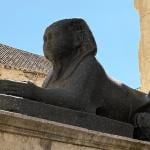As I discussed in the previous blog, that rather humorous passage about the Queen of Heaven in Jeremiah. . . but Kate Gladstone chides me for not knowing that that passage is not in the current calendar of haftarot. Perhaps it may have been back then, but . . . Anyway, “Queen of Heaven” was a title used for many goddesses in the Hellenistic world. Could there still have been any genuine belief in a Queen of Heaven in the Judea of Jesus’ time? Any awareness of Her as still being Yahweh’s wife and the manifestation of the divine as feminine? There are hints that there might have been. After all, why was the title so soon bestowed on Jesus’ mother? Further, one can now ask whether it was conferred on the wrong Mary. But what is obviously most conclusive is that, as I read the documents, Jesus flat out talked about her.
In order to make progress toward answering those questions, just as the previous blog dealt with Jeremiah, this one needs to deal with Mark. Let me emphasize that what you are reading here is not crackpot heresy. It is mainstream Biblical scholarship, not for Evangelicals, fundamentalists, and conservative Catholics, of course, but definitely for liberal Christians, such as most Anglicans.
Any attempt to understand Jesus—Rabbi Yeshua ha-Notsri—as an historical human being has to early on look at the opening of the Gospel According to Mark. For clarity, let me explain the scholarly shorthand for talking about the gospels. “Mk” means the Gospel According to Mark itself as a piece of writing, whereas “Mark” refers to the otherwise unknown author of that gospel. Similarly, we have Mt, Lk, and Jn as symbols for those gospels. Back in my graduate student days, I added “Tm” as the symbol for the Gospel According to Thomas. Why?
All the members of the Jesus Seminar founded by the late Robert Funk agreed that Tm is neither more nor less authentic as an historical document than the four canonicals. To give that gospel an abbreviation like “EvThom” immediately symbolizes it as being inferior to the canonicals and thus militates toward underestimating its value. Antoinette Wire, one of the original Nag Hammadi translators, with whom I had the honor and pleasure of studying Coptic and the Nag Hammadi documents, agreed that my innovation was logical and useful. She graciously accepted my invitation to be on my comprehensive exam committee. For the exam in New Testament Studies, I wrote a major paper demonstrating a direct connection textual connection between Tm and Jn. She ruled that my methodology in it was “not tight, but adequate.” So, guys, see: I do have a few real credentials about all this stuff.
Growing up Catholic, one hears during Mass only excerpts from the gospels, all mixed together. One therefore gets the impression that they all tell the same story. No, they don’t. They were written by four different men, each with a different theory about who and what Jesus was. The gospels contradict each other in hundreds of ways, and they cannot be harmonized into a single story unless one throws out about half the information they collectively contain. Of course, people have been trying to force them into a single story since very early on. One of the first attempts was Tatian’s Diatessaron, which was used as the accepted text in some communities and which can be found in the Ante-Nicene Fathers volumes, now available for free online.
As I recall, it was Hugh Schonfield’s accurate and insightful translation titled The Authentic New Testament that in 1971 focused my attention on the “synoptic problem,” which deals with the ways in which the gospels do and do not match each other, and thus set me on the path that led to my doctorate. Schonfield seemed a little more trustworthy than most biblical scholars and less likely to indulge in pious twaddle, not because of his Passover Plot, but because I knew from Ithell Colquhon’s useful history of the Hermetic Order of the Golden Dawn that Schonfield had been a member of the chapter headed by the famous Egyptologist E. A. Wallis Budge. Yeah, all those radical Brits back then knew each other.
Alta wondered why, as we wandered around northernCaliforniafor a week in late 1971 as our honeymoon, I was stealing the Gideon Bible from each motel we stopped at. I needed them as raw materials to begin working on the synoptic problem for myself. I knew the King James version was the worst possible translation for scholarly purposes, but at least it was free and its mistakes could be corrected. I began working on the problem for some months, pasting columns of text excised from the Gideon Bibles onto large sheets of poster board (you young whippersnappers don’t appreciate how much Word has simplified life for scholars) and became so frustrated that I decided it was impossible, threw out all that work, and sold all the reference books. But the question would not go away. It kept niggling and nudging at me until I finally reacquired all the needed books and went back to work on it.
In The Authentic New Testament, Schonfield recommends that one read Lk first, because it incorporates most of what is in the other gospels. That’s logical, since I later learned that Lk was the last of the four to be written. However, since Schonfield also mentions that Mk was the earliest of the four, I decided to read it first—and I’ve always been glad that I did it that way, because reading straight through it for the first time, I was seeing it with fresh eyes.
In Mk I was reading the story of a gifted faith healer who gradually began to think that he might be the Messiah. His were the kinds of talents I knew about from hanging out with Witches, psychics, magicians, parapsychologists, and suchlike; it seemed like familiar turf. Faith healing is a normal human talent—it might be just the placebo effect—but he was apparently unusually good at it. Then in Mt the story is turned upside-down. Jesus knows all along that he is the Messiah, but does a little faith healing on the side, and that’s the assumption in Lk and Jn as well.
Mark is hands down the most brilliant of all the New Testament authors. For one thing, he invented the gospel as a new literary form; that is comparable to Aeschylus’ invention of drama. He is also the most subtle and devious. It’s amusing that Paul thought he was subtle. No, Paul lets it all hang out. But Mk, the shortest and least pretentious of the four canonicals, is in many ways the most important. It is a mark of Mark’s genius that it took about eighteen centuries before anyone figured that out.
Mark’s story is disingenuous. It reads like simple reporting of what Jesus said and did, and of what happened, without any editorializing. But that appearance of simplicity is itself the most brilliant aspect of what Mark achieved in his gospel.
I’ve been accumulating information about Mark (and Mk) for many years, enough to write a fairly lengthy commentary on that gospel, although at this moment I doubt I’ll ever get around to doing that. The great nineteenth-century scholars, such as Bruno Baur, had deduced that Mark had constructed his story by carefully choosing the bits and pieces he wanted out of all the oral traditions that were circulating by around 69 CE. All that work is well summarized in Albert Schweitzer’s The Quest for the Historical Jesus, a topic not yet exhausted—and perhaps it never will be. Another major breakthrough was achieved by Willi Marxsen, and recently I discovered by accident one of the most useful discussions of Mk I have ever come across: Robert M. Price’s longish essay, “Messiah as Mishnah,” which you can find on his website, along with a vast number of other excellent essays.
That’s about enough verbiage for today. I will continue discussing Mark in the next eptsode. More will be revealed.











